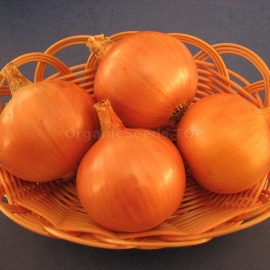
«Varangian» - Ukrainian Heirloom Onion Seeds
1.14 €
Choose Varangian storage onion seeds for a very reliable, medium-sized, round onion with dark-yellow skin and a narrow neck. It cannot be beaten among hard types for long storage.
-
Organic Onion «Varangian»
Choose Varangian storage onion seeds for a very reliable, medium-sized, round onion with dark-yellow skin and a narrow neck. It cannot be beaten among hard types for long storage.
It tastes just as sweet and pungent in the spring as it did when harvested the previous fall. Varangian remains the best long day storage onion we know of, so it’s a great choice for homesteaders or anyone interested in economy in the garden.
In late summer, when the onions have formed nice bulbs, harvest them as needed. At full maturity, the tops of the onions will fall over, signalling the end of growth and the time to harvest. If no rain or frost in forecast, simply knock each onion over the rest of the way. This will break the roots’ contact with the soil and begin the drying process. Leave the onions like that for two or three days.
At the very first mention of rain or frost, bring the whole onion plants indoors and lay them out in a dry area away from direct sunlight. Leave them to cure for two to four weeks until there is no more green showing in the stems, leaves, or necks. During this time, the papery skins covering each bulb will harden and contract.
How to Grow
The common practice is to break or crush the onion stems if there are signs of flower heads. When the stems are dry, dig the bulbs, which can be left on top of the ground to cure and dry for several days.
Setting out onion plants that are too large, planting too early or using the wrong varieties usually causes onions to bolt or form undersize bulbs.
The rest of the onion family; garlic, leeks, and shallots, should be planted in the fall if you're in the South and in late winter/early spring in the North. Gardeners in plant hardiness Zone 7 and further south will be mostly fall planters. From Zone 6 north check with the local Extension office for recommended planting times. Leeks, though not a traditional southern crop, are very easy to grow as a winter vegetable from the Gulf Coast, south. The same can be said for garlic. 'Early Italian' and 'Extra Select' are softneck varieties of garlic best adapted to most gardens in the U.S. In Zones 4 and above the hardneck garlics may be worth a try.
